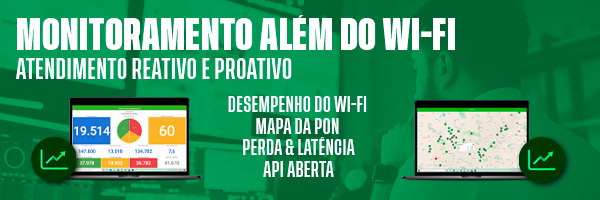Quando falamos sobre serviços de rede, existem vários fatores, inclusive no gerenciamento de hardware, que afetam a qualidade do serviço de internet oferecido.
Existem duas indicações que possuem relação com isso: o QoS e o QoE. Confira esse conteúdo para entender melhor a diferença entre esses dois termos e a importância que exercem sobre a qualidade oferecida nos serviços de rede.
O que é e como funciona o QOS?

A sigla QoS (Quality of Service) significa “Qualidade de Serviço”, uma tecnologia que utiliza de elementos de configuração de hardware (roteadores) para controlar a priorização de velocidade de sinal entre um grupo de usuários e dispositivos que estão consumindo a banda da conexão.
O QoS, inclusive, garante que a rede Wi-Fi priorize esse sinal em momentos de sobrecarga, onde vários dispositivos realizam transmissão e download de grandes volumes de dados de forma simultânea.
Para isso, ele realiza a divisão da banda para todas as operações, garantindo que tráfegos específicos sejam priorizados conforme a velocidade exigida, o que provê uma conexão mais estável para todos os usuários ao mesmo tempo.
Esse fator pode ser influenciado por consumos de dados de diferentes origens, como downloads de arquivos muito grandes, acessos de dispositivos móveis, reprodução de conteúdos de streaming em alta resolução, transmissão de vídeos ao vivo e inclusive jogos online que utilizam conexão com a internet.
Por exemplo, na mesma rede pode haver usuários realizando diferentes atividades. Enquanto uma pessoa assiste a um streaming em 4K, outra pode estar realizando uma videoconferência. O alocamento de banda garante que ambos usem a internet sem travamentos ou baixa qualidade de imagem e áudio.
Existem roteadores que já oferecem essa função, sendo que ela pode ser configurada de forma facilitada pelo usuário, ou com a ajuda do provedor de rede contratado e que oferece o serviço.
Alguns modelos de roteadores, inclusive, possuem a função de QoS configurada de forma automática, realizando o processo de priorização por conta própria sem a solicitação do usuário, ainda que essa não seja uma realidade presente na maioria dos aparelhos.
A solução Flashbox, da Anlix, é a melhor opção para que o provedor consiga fazer o gerenciamento remoto de equipamentos na casa de clientes, a fim de prestar o melhor serviço de internet.
Além de compatível com vários fabricantes, oferece um ambiente integrado para facilitar o atendimento ao cliente. Faça um rápido cadastro e experimente na sua operação!
O que é o QoE?

A outra sigla, QoE (Quality of Experience), é traduzida como “Qualidade da Experiência”, sendo relacionada a como é criada a percepção de qualidade do serviço pelo usuário final e sua opinião, considerando o desempenho da rede ofertada (como exemplo, considerando parâmetros de QoS da rede como perda de pacotes, jitter, latência entre outros).
É a QoE que consegue analisar de forma mais inteligente o impacto do comportamento da rede no usuário final, considerando que certas sobrecargas, por mais que pareçam insignificantes, podem prejudicar o desempenho de um serviço ou programa usado.
Por exemplo, em um ambiente empresarial, uma perda de pacote de 5% pode ter um impacto insignificante em um sistema de CRM baseado em nuvem. Já uma perda de pacote de 0,5% pode resultar em uma redução de 30% em taxa de transferência de dados.
A QoE cumpre seu objetivo também observando as informações sobre os dados enviados pela rede, não apenas a eficiência do transporte de dados por ela. Em uma chamada VoIP, por exemplo, a QoE pode analisar o eco, a qualidade da conversação, o nível de áudio e as imperfeições na ligação.
A QoE possui relação com a QoS de forma indireta, já que essa segunda é necessária ser implementada corretamente para que as métricas QoE também possam alcançar bons resultados entre os consumidores.
O ideal é que sempre sejam feitas checagens periódicas para garantir que a QoE esteja mantendo bons níveis de satisfação, permitindo ajustes necessários para aprimorar os serviços de rede.
Geralmente, a QoE pode ser medida através de visitas técnicas, acompanhamento telefônico ou através de outros canais entre o provedor e o cliente final, permitindo que ele acompanhe a performance da conexão oferecida. Os conceitos normalmente usados na avaliação ficam entre “excelente”, “bom” e “ruim/pobre”.
A plataforma Flashboard, da Anlix, é a melhor ferramenta para medição de QoE que facilita a tomada de decisões do provedor.
O Módulo de Qualidade do Wi-Fi permite o provedor antecipe possíveis problemas ao atribuir uma nota da qualidade de conexão para cada cliente e cada dispositivo conectado ao roteador na casa do cliente.
Com isso, o provedor terá uma melhora no atendimento do suporte, que estará empoderado para medir a qualidade da experiência do cliente e garantir a sua satisfação, e consequentemente, uma redução de cancelamento do serviço.
Métricas de QoS que afetam a QoE
Com essa relação direta entre os dois termos, existem algumas métricas de QoS que possuem impacto direto na métrica de QoE, ou seja, na experiência final do cliente.
- O nível de sinal é uma delas, medindo a latência do sinal recebido pelos dispositivos. Quanto mais alta a potência do sinal, melhor a qualidade de transmissão de dados.
- A velocidade do Wi-Fi também é considerada, independente dos diferentes padrões disponíveis no Brasil (A, B, G, N e AC).
- A latência é outra métrica que mede a quantidade de tempo que um pacote de dados demora para ser enviado entre computadores. Ou seja, o ideal é encontrar a menor taxa de latência possível para garantir a qualidade da conexão.
- A variação da latência também é acompanhada, chamada “jitter” em inglês, o que também impacta no desempenho da rede e na qualidade de uso do cliente final.
Assim, ainda que sejam termos diferentes, QoS e QoE possuem ligação na manutenção da qualidade da rede, sendo que a primeira foca na distribuição de banda para diferentes demandas.
A QoE se relaciona com a percepção do cliente final sobre a qualidade do serviço prestado, mas ambas são métricas importantes para serem acompanhadas e desenvolvidas pelos prestadores de rede.




Deixar um comentário